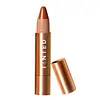What's inside
What's inside
 Key Ingredients
Key Ingredients

 Benefits
Benefits

 Concerns
Concerns

 Ingredients Side-by-side
Ingredients Side-by-side

Caprylic/Capric Triglyceride
MaskingWater
Skin ConditioningCera Microcristallina
Emulsion StabilisingSynthetic Wax
AbrasiveC9-12 Alkane
SolventTridecyl Trimellitate
EmollientPropanediol
SolventMica
Cosmetic ColorantPolyglyceryl-3 Diisostearate
EmulsifyingGlycerin
HumectantButylene Glycol
HumectantPolyglyceryl-6 Polyricinoleate
EmulsifyingSodium Chloride
Masking3-O-Ethyl Ascorbic Acid
Skin ConditioningTetrahexyldecyl Ascorbate
AntioxidantCaffeine
Skin ConditioningTocopherol
AntioxidantPoncirus Trifoliata Fruit Extract
Skin ConditioningCitrus Nobilis Fruit Extract
MaskingCitrus Paradisi Peel Extract
PerfumingJojoba Esters
EmollientEthylhexylglycerin
Skin ConditioningSodium Phytate
Polysilicone-11
Phenoxyethanol
PreservativeTin Oxide
AbrasiveIron Oxides
CI 77891
Cosmetic ColorantCaprylic/Capric Triglyceride, Water, Cera Microcristallina, Synthetic Wax, C9-12 Alkane, Tridecyl Trimellitate, Propanediol, Mica, Polyglyceryl-3 Diisostearate, Glycerin, Butylene Glycol, Polyglyceryl-6 Polyricinoleate, Sodium Chloride, 3-O-Ethyl Ascorbic Acid, Tetrahexyldecyl Ascorbate, Caffeine, Tocopherol, Poncirus Trifoliata Fruit Extract, Citrus Nobilis Fruit Extract, Citrus Paradisi Peel Extract, Jojoba Esters, Ethylhexylglycerin, Sodium Phytate, Polysilicone-11, Phenoxyethanol, Tin Oxide, Iron Oxides, CI 77891
Coco-Caprylate/Caprate
EmollientC12-15 Alkyl Benzoate
AntimicrobialPolyethylene
AbrasiveEthylhexyl Palmitate
EmollientOctyldodecanol
EmollientMica
Cosmetic ColorantSucrose Acetate Isobutyrate
Silica
AbrasiveCandelilla Cera
EmollientAluminum Starch Octenylsuccinate
AbsorbentOctyldodecyl Neopentanoate
EmollientLecithin
EmollientSqualane
EmollientLauroyl Lysine
Skin ConditioningHydrolyzed Hyaluronic Acid
HumectantTocopherol
AntioxidantTetrahexyldecyl Ascorbate
AntioxidantPentaerythrityl Tetra-Di-T-Butyl Hydroxyhydrocinnamate
AntioxidantDisteardimonium Hectorite
StabilisingPolymethylsilsesquioxane
Hdi/Trimethylol Hexyllactone Crosspolymer
Water
Skin ConditioningPropylene Carbonate
SolventCalcium Sodium Borosilicate
Synthetic Fluorphlogopite
Calcium Aluminum Borosilicate
Tin Oxide
AbrasiveCaprylyl Glycol
EmollientCoco-Caprylate/Caprate, C12-15 Alkyl Benzoate, Polyethylene, Ethylhexyl Palmitate, Octyldodecanol, Mica, Sucrose Acetate Isobutyrate, Silica, Candelilla Cera, Aluminum Starch Octenylsuccinate, Octyldodecyl Neopentanoate, Lecithin, Squalane, Lauroyl Lysine, Hydrolyzed Hyaluronic Acid, Tocopherol, Tetrahexyldecyl Ascorbate, Pentaerythrityl Tetra-Di-T-Butyl Hydroxyhydrocinnamate, Disteardimonium Hectorite, Polymethylsilsesquioxane, Hdi/Trimethylol Hexyllactone Crosspolymer, Water, Propylene Carbonate, Calcium Sodium Borosilicate, Synthetic Fluorphlogopite, Calcium Aluminum Borosilicate, Tin Oxide, Caprylyl Glycol
Ingredients Explained
These ingredients are found in both products.
Ingredients higher up in an ingredient list are typically present in a larger amount.
Mica is a naturally occurring mineral used to add shimmer and color in cosmetics. It can also help improve the texture of a product or give it an opaque, white/silver color.
Serecite is the name for very fine but ragged grains of mica.
This ingredient is often coated with metal oxides like titanium dioxide. Trace amounts of heavy metals may be found in mica, but these metals are not harmful in our personal products.
Mica has been used since prehistoric times throughout the world. Ancient Egyptian, Indian, Greek, Roman, Aztec, and Chinese civilizations have used mica.
Learn more about MicaTetrahexyldecyl Ascorbate (THD) is a stable and oil-soluble form of Vitamin C.
THD is special in that it has the ability to travel deeper into skin than traditional ascorbic acid while maintaining the same skin benefits (double win!).
Because it’s oil-soluble, THD dives deep into your skin’s fatty layers (think ceramides and cholesterol) to fight off the kind of free radicals that mess with your skin barrier. This makes it a great pair with water-based vitamin C (ascorbic acid) that mainly works on the surface.
Even at just 0.1%, THD is already showing great antioxidant activity. When used up to 2%, it helps keep your skin happy and calm, especially when it’s stressed from pollution or sun.
Want to fade dark spots or tackle hyperpigmentation? You’ll want 5% or more. Pairing it with brightening buddies like niacinamide or licorice root gives even better results. One study even used 30% THD with other brighteners and saw real results on stubborn discoloration, even in melasma-prone skin.
A note on THD: It’s has a slightly silky, oily texture and usually shows up colorless or pale yellow (though the exact shade can vary by supplier).
While you can sneak it into water-based formulas, it really shines when paired with silicones or oils, which help your skin soak it up better.
THD is pretty stable, but it’s still vulnerable to degradation like ascorbic acid. Too much light or heat (above 113°F / 45°C) can break it down over time. Go for dark and opaque packaging that keeps it safe and shady!
Read more about other types of Vitamin C:
Learn more about Tetrahexyldecyl AscorbateTin Oxide is an inorganic oxide used to add opacity and volume to a product. In nature, it is already found in mineral form. The main ore of tin is an opaque and shiny mineral called casseterite.
Tin Oxide helps remove translucency in a product, or make it more opaque. Besides adding opacity, tin oxide is used for bulking to add volume.
Tocopherol (also known as Vitamin E) is a common antioxidant used to help protect the skin from free-radicals and strengthen the skin barrier. It's also fat soluble - this means our skin is great at absorbing it.
Vitamin E also helps keep your natural skin lipids healthy. Your lipid skin barrier naturally consists of lipids, ceramides, and fatty acids. Vitamin E offers extra protection for your skin’s lipid barrier, keeping your skin healthy and nourished.
Another benefit is a bit of UV protection. Vitamin E helps reduce the damage caused by UVB rays. (It should not replace your sunscreen). Combining it with Vitamin C can decrease sunburned cells and hyperpigmentation after UV exposure.
You might have noticed Vitamin E + C often paired together. This is because it is great at stabilizing Vitamin C. Using the two together helps increase the effectiveness of both ingredients.
There are often claims that Vitamin E can reduce/prevent scarring, but these claims haven't been confirmed by scientific research.
Learn more about TocopherolWater. It's the most common cosmetic ingredient of all. You'll usually see it at the top of ingredient lists, meaning that it makes up the largest part of the product.
So why is it so popular? Water most often acts as a solvent - this means that it helps dissolve other ingredients into the formulation.
You'll also recognize water as that liquid we all need to stay alive. If you see this, drink a glass of water. Stay hydrated!
Learn more about Water